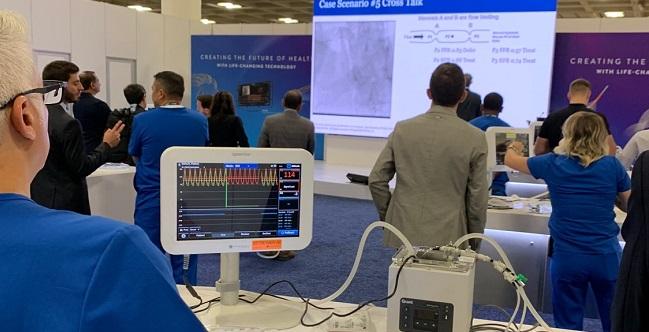Off Script: The New Gatekeepers of Procedural Education
Does the proliferation of simulation training pavilions at cardiovascular conferences signal a shift in cardiology education?

SAN FRANCISCO, CA— I spent my second day at TCT 2019 sampling the excellent selection of practical educational opportunities in the TCT Training Pavilion and speaking to some of the professional staff supporting industry-led training programs. The last few years have seen a proliferation in the popularity of “teaching pavilions” at interventional cardiology conferences in which small group skill training is taught by experienced interventionalists, usually with the use of sophisticated procedural simulators. I found myself wondering: what has led to their rise in popularity, why are they found primarily at major meetings, and do they fulfill an important need?
This week, most fascinating to me was an intracoronary physiology teaching session (sponsored by Abbott) in which we had an opportunity to work on a wet-lab pulsatile flow model, simulating normal and hyperemic flow physiology. This very effectively demonstrated the differences between traditional FFR and the resting flow measurement of RFR, as well as the confusing and otherwise hard to teach “cross talk” between either sequential or bifurcation lesions. The ability to have direct control over introducing physical stenoses in a simulated heart model in various permutations, and to directly see the effect on our measurements, allowed me to quickly understand otherwise complicated relationships frequently seen in the real world, which if not managed correctly would have led to incorrect decisions being made in patient care. Research on the efficacy and durability of such training in these short sessions is lacking. Yet their packed attendance and popularity indicates at some level the fulfillment of an important gap in our professional education. Anecdotally, from my experience and talking to my co-attendees, the perceived educational value was very high, and many felt that such training should be accessible to learners from every level. So why are such educational sessions not available in the course of normal interventional cardiology education?
The primary answer to the question is cost. These simulation training devices don’t come cheap; the degree of technical sophistication, the very specific nature of their use, and the need for technically competent support staff contribute to price tags that are far and above normal local education budgets. Basic economics therefore dictates that such training must be regional and concentrated for maximum efficiency. The price tags also almost always require industry support. There has been a longstanding debate on the conflicts introduced by industry-sponsored education with some factions advocating a total prohibition of industry involvement in education. This led the European Society of Cardiology to publish a position paper in June declaring their position on “The future of continuing medical education: the roles of medical professional societies and the healthcare industry.”
I feel I need to be provocative here and say that the last few years in interventional cardiology particularly have shown industry’s ability to innovate in training, lead educationally, and arguably to even establish competency standards for their own devices. The structural programs established for TAVR, MitraClip, and the Watchman device are excellent examples of the synergy that can be achieved with industry-led but medical society-monitored educational, , and proctoring programs. These programs have been instituted around the world on a careful, structured, and sizeable scale and have led to superb, consistent clinical outcomes for patients even at new programs. Remarkably, these results have been achieved globally despite the inherent differences in regional training.
As a further example of the power of industry driven innovation, almost all progress in cardiovascular simulation in education has been from industry over the last 10 years. Almost all new modules in this time period in interventional cardiology digital procedural simulation have been industry-sponsored and industry-guarded, since access to these modules are proprietary. Those of us who own digital simulators in our ACGME training programs don’t as a rule have access to the current best-in-class industry modules. Our professional societies, not having the development resources or staying power, have merely paid lip service to the idea of incorporating simulation in education curricula or simply giving up, with the refrain: “Simulation is not real enough to be useful.” Arguing from moral first principles, however, in which no patient is ever practiced upon if alternatives exist, the correct statement is: “Simulation is currently not good enough to be useful. We must make it better.”
Where are the TCT, ACC, AHA, SCAI, or ESC themed sessions or effective work groups on making simulation (which clearly has a role to play) better? If professional societies continue to stand by, I say we allow industry to take point position while ensuring our societies concentrate on adopting a strong oversight role to ensure fair and balanced representation. If we fail to do so, we may end up having to accept that they could become future gatekeepers to competency and training.
Off Script is a first-person blog written by leading voices in the field of cardiology. It does not reflect the editorial position of TCTMD.
Kwan S Lee, MD is an Associate Professor of Medicine at the Sarver Heart Center, University of Arizona. As interventional…
Read Full Bio

Nathan Eyre